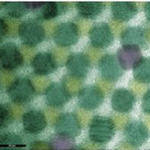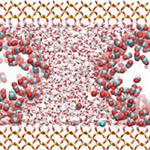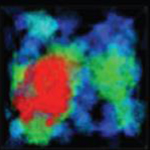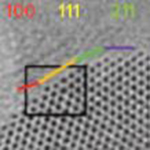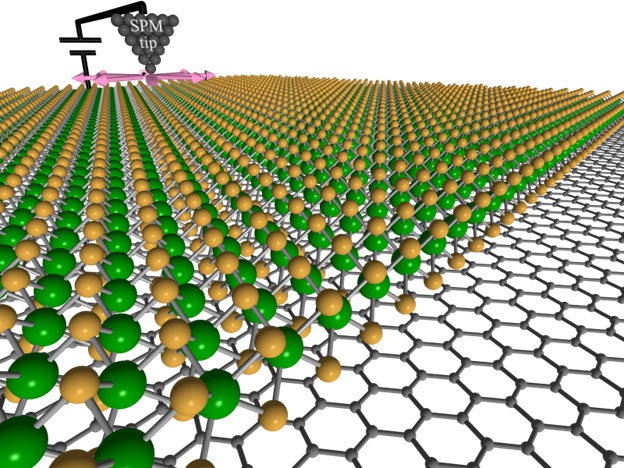Transformative Opportunities Addressed by EFRCs
In 2014, the Department of Energy's Office of Science charged the Basic Energy Sciences Advisory Committee (BESAC) to assess the progress made on the five Grand Challenges identified in the 2007 BESAC report, Directing Matter and Energy: Five Challenges for Science and the Imagination, and determine what new knowledge opportunities exist to advance energy science. The findings are given in a 2015 report, Challenges at the Frontiers of Matter and Energy: Transformative Opportunities for Discovery Science. This report highlights striking recent discoveries made in pursuit of the Grand Challenges that open compelling new research directions with the potential to transform the methods, reach, and impact of energy science and technology. It also presents five new Transformative Opportunities that reflect the breakthrough potential of research supported by the Office of Basic Energy Sciences (BES). Each Energy Frontier Research Center addresses one or more of these transformative opportunities. Past EFRCs, active in 2014-2020, who have self-identified as addressing each transformative opportunity are listed below.
Transformative Opportunity #1: Mastering Hierarchical Architectures and Beyond-Equilibrium Matter
A new horizon for materials design is the opportunity to precisely control the placement of atoms in order to form desirable hierarchical structures, which, in turn, deliver novel properties. Of particular promise is the ability to predict and control non-equilibrium structures which are prevalent in nature in synthetic systems.
| Years | Lead Institution | Director(s) | Center Name |
|---|---|---|---|
| 2009-2018 | Carnegie Institution of Washington | Ho-kwang Mao (8/1/2009 - 7/31/2014); Russell Hemley (8/1/2014 - 7/31/2018) | Energy Frontier Research in Extreme Environments (Efree) |
| 2009-2018 | Los Alamos National Laboratory | Victor Klimov | Center for Advanced Solar Photophysics (CASP) |
| 2009-2018 | Purdue University | Maureen McCann | Center for Direct Catalytic Conversion of Biomass to Biofuels (C3Bio) |
| 2009-2018 | University of Notre Dame | Peter Burns | Materials Science of Actinides (MSA) |
| 2009-2018 | Washington University in St. Louis | Robert Blankenship | Photosynthetic Antenna Research Center (PARC) |
| 2009-2020 | Argonne National Laboratory | Michael Thackeray (8/1/2009 - 7/31/2014); Paul Fenter (8/1/2014 - 7/31/2020) | Center for Electrical Energy Storage (CEES) (8/1/2009 - 7/31/2014); Center for Electrochemical Energy Science (CEES) (8/1/2014 - 7/31/2020) |
| 2009-2020 | Northwestern University | Michael Wasielewski | Argonne-Northwestern Solar Energy Research Center (ANSER) (8/1/2009 - 7/31/2018); Center for Light Energy Activated Redox Processes (LEAP) (8/1/2018 - 7/31/2020) |
| 2009-2020 | University of California, Berkeley | Berend Smit (8/1/2009 - 7/31/2014); Jeffrey Long (8/1/2014 - 7/31/2020) | Center for Gas Separations (CGS) |
| 2009-2020 | University of Maryland | Gary Rubloff | Nanostructures for Electrical Energy Storage (NEES) |
| 2014-2020 | National Renewable Energy Laboratory | William Tumas | Center for Next Generation of Materials Design (CNGMD) |
| 2014-2020 |
Oak Ridge National Laboratory | Yanwen Zhang |
Energy Dissipation to Defect Evolution (EDDE) |
| 2009-2022 | Oak Ridge National Laboratory | Shang Dai | Fluid Interface Reactions, Structures and Transport Center (FIRST) |
| 2009-2022 | University of Delaware | Dionisios Vlachos | Catalysis Center for Energy Innovation (CCEI) |
| 2014-2022 | Harvard University | Cynthia Friend | Integrated Mesoscale Architectures for Sustainable Catalysis (IMASC) |
| 2014-2022 | University of California, Riverside | Laura Gagliardi | Inorganometallic Catalyst Design Center (ICDC) |
| 2016-2022 | Florida State University | Thomas Albrecht-Schoenzart | Center for Actinide Science & Technology (CAST) |
Transformative Opportunity #2: Beyond Ideal Materials and Systems: Understanding the Critical Roles of Heterogeneity, Interfaces, and Disorder
Real materials contain heterogeneity, interfaces, and disorder, which proliferate at the mesoscale and often control the macroscopic behavior of materials. Advances in simulation, synthesis, and characterization hold the promise of moving beyond the familiar ideal homogeneous systems to master these structural complexities, turning "defects" into new design tools. Such advances can lead to a transformative impact in energy materials used for solar and nuclear power, hydraulic fracturing, power conversion, airframes, and batteries.
| Years | Lead Institution | Director(s) | Center Name |
|---|---|---|---|
| 2009-2018 | California Institute of Technology | Harry Atwater (8/1/2009-1/30/2015); Ralph Nuzzo (2/1/2015 - 7/31/2018) | Light-Material Interactions in Energy Conversion (LMI) |
| 2009-2018 | Carnegie Institution of Washington | Ho-kwang Mao (8/1/2009 - 7/31/2014); Russell Hemley (8/1/2014 - 7/31/2018) | Energy Frontier Research in Extreme Environments (Efree) |
| 2009-2018 | Lawrence Berkeley National Laboratory | Donald DePaolo | Center for Nanoscale Control of Geologic CO2 (NCGC) (8/1/2009 - 7/31/2014); Center for Nanoscale Controls on Geologic CO2 (NCGC) (8/1/2014 - 7/31/2018) |
| 2009-2018 | Los Alamos National Laboratory | Victor Klimov | Center for Advanced Solar Photophysics (CASP) |
| 2009-2018 | Massachusetts Institute of Technology | Marc Baldo | Center for Excitonics (CE) |
| 2009-2018 | University of Notre Dame | Peter Burns | Materials Science of Actinides (MSA) |
| 2009-2018 | University of Texas at Austin | Gary Pope (8/1/2009 - 6/30/2013); Steven Bryant (7/1/2013 - 8/30/2014); Larry Lake (9/1/2014 - 7/31/2018) | Center for Frontiers of Subsurface Energy Security (CFSES) |
| 2009-2018 | Washington University in St. Louis | Robert Blankenship | Photosynthetic Antenna Research Center (PARC) |
| 2014-2018 | University of Illinois at Urbana-Champaign | Robert Finley (8/1/2015 - 4/15/2015); Scott Frailey (4/16/2015 - 7/31/2018) | Center for Geologic Storage of CO2 (GSCO2) |
| 2009-2020 | Argonne National Laboratory |
Michael Thackeray (8/1/2009 - 7/31/2014); Paul Fenter (8/1/2014 - 7/31/2020) | Center for Electrical Energy Storage (CEES) (8/1/2009 - 7/31/2014); Center for Electrochemical Energy Science (CEES) (8/1/2014 - 7/31/2020) |
| 2009-2020 | Stony Brook University (8/1/2009 - 7/31/2014); Binghamton University (8/1/2014 - 7/31/2020) | Clare Grey (8/1/2009 - 6/17/2011); M. Stanley Whittingham (6/18/2011 - 7/31/2020) | NorthEast Center for Chemical Energy Storage (NECCES) |
| 2009-2020 | Northwestern University | Michael Wasielewski | Argonne-Northwestern Solar Energy Research Center (ANSER) (8/1/2009 - 7/31/2018); Center for Light Energy Activated Redox Processes (LEAP) (8/1/2018 - 7/31/2020) |
| 2009-2020 | University of California, Berkeley | Berend Smit (8/1/2009 - 7/31/2014); Jeffrey Long (8/1/2014 - 7/31/2020) | Center for Gas Separations (CGS) |
| 2009-2020 | University of Maryland | Gary Rubloff | Nanostructures for Electrical Energy Storage (NEES) |
| 2009-2020 | University of North Carolina at Chapel Hill | Thomas J. Meyer (8/1/2009 - 7/31/2018); Gerald Meyer (8/1/2018 - 7/31/2020) | Center for Solar Fuels (UNC) (8/1/2009 - 7/31/2018); Alliance for Molecular PhotoElectrode Design for Solar Fuels (AMPED)(8/1/2018 - 7/31/2020) |
| 2014-2020 | National Renewable Energy Laboratory | William Tumas | Center for Next Generation of Materials Design (CNGMD) |
| 2014-2020 | Oak Ridge National Laboratory | Yanwen Zhang | Energy Dissipation to Defect Evolution (EDDE) |
| 2014-2020 | Temple University | John Perdew | Center for the Computational Design of Functional Layered Materials (CCDM) (8/1/2014 - 7/31/2018); Center for Complex Materials from First Principles (CCM)(8/1/2018 - 7/31/2020) |
| 2014-2020 | University of California, Riverside | Jing Shi | Spins and Heat in Nanoscale Electronic Systems (SHINES) |
| 2009-2022 | Oak Ridge National Laboratory | Shang Dai | Fluid Interface Reactions, Structures and Transport Center (FIRST) |
| 2009-2022 | University of Delaware | Dionisios Vlachos | Catalysis Center for Energy Innovation (CCEI) |
| 2014-2022 | Harvard University | Cynthia Friend | Integrated Mesoscale Architectures for Sustainable Catalysis (IMASC) |
| 2014-2022 | University of California, Riverside | Laura Gagliardi | Inorganometallic Catalyst Design Center (ICDC) |
| 2016-2022 | Ohio State University | Gerald Frankel | Center for Performance and Design of Nuclear Waste Forms and Containers (WastePD) |
Transformative Opportunity #3: Harnessing Coherence in Light and Matter
Coherence in quantum mechanical phenomena is a powerful force with direct far-reaching macroscopic implications. Recent advances have greatly enhanced our ability to observe and control coherence in both light and matter. Success in developing and exploiting these advances could revolutionize fields as diverse as information processing, sensor technology, and energy generation through the control of the outcome of chemical reactions or the instantaneous state of a material.
| Years | Lead Institution | Director(s) | Center Name |
|---|---|---|---|
| 2009-2018 | California Institute of Technology | Harry Atwater (8/1/2009-1/30/2015); Ralph Nuzzo (2/1/2015 - 7/31/2018) | Light-Material Interactions in Energy Conversion (LMI) |
| 2009-2018 | Massachusetts Institute of Technology | Marc Baldo | Center for Excitonics (CE) |
| 2009-2018 | Massachusetts Institute of Technology | Gang Chen | Solid-State Solar-Thermal Energy Conversion Center (S3TEC) |
| 2009-2018 | Washington University in St. Louis | Robert Blankenship | Photosynthetic Antenna Research Center (PARC) |
Transformative Opportunity #4: Revolutionary Advances in Models, Mathematics, Algorithms, Data, and Computing
The convergence of recent rapid advances in theoretical, mathematical, computational, and experimental capabilities promises to transform our ability to find, predict, and control new materials and chemical processes; understand complex matter across a range of length and time scales; and steer experiments toward deep scientific insights.
| Years | Lead Institution | Director(s) | Center Name |
|---|---|---|---|
| 2009-2018 | California Institute of Technology | Harry Atwater (8/1/2009-1/30/2015); Ralph Nuzzo (2/1/2015 - 7/31/2018) | Light-Material Interactions in Energy Conversion (LMI) |
| 2009-2018 | Lawrence Berkeley National Laboratory | Donald DePaolo | Center for Nanoscale Control of Geologic CO2 (NCGC) (8/1/2009 - 7/31/2014); Center for Nanoscale Controls on Geologic CO2 (NCGC)(8/1/2014 - 7/31/2018) |
| 2009-2018 | Los Alamos National Laboratory | Victor Klimov | Center for Advanced Solar Photophysics (CASP) |
| 2009-2018 | University of Texas at Austin | Gary Pope (8/1/2009 - 6/30/2013); Steven Bryant (7/1/2013 - 8/30/2014); Larry Lake (9/1/2014 - 7/31/2018) | Center for Frontiers of Subsurface Energy Security (CFSES) |
| 2014-2018 | University of Illinois at Urbana-Champaign | Robert Finley (8/1/2015 - 4/15/2015); Scott Frailey (4/16/2015 - 7/31/2018) | Center for Geologic Storage of CO2 (GSCO2) |
| 2014-2020 | National Renewable Energy Laboratory | William Tumas | Center for Next Generation of Materials Design (CNGMD) |
| 2014-2020 | Oak Ridge National Laboratory | Yanwen Zhang | Energy Dissipation to Defect Evolution (EDDE) |
| 2014-2020 | Temple University | John Perdew | Center for the Computational Design of Functional Layered Materials (CCDM) (8/1/2014 - 7/31/2018); Center for Complex Materials from First Principles (CCM) (8/1/2018 - 7/31/2020) |
| 2014-2020 | Montana State University (8/1/2014 - 7/31/2018); Washington State University (8/1/2018 - 7/31/2020) | John Peters | Biological Electron Transfer and Catalysis Center (BETCy) |
| 2009-2022 | University of Delaware | Dionisios Vlachos | Catalysis Center for Energy Innovation (CCEI) |
| 2014-2022 | Harvard University | Cynthia Friend | Integrated Mesoscale Architectures for Sustainable Catalysis (IMASC) |
| 2014-2022 | University of California, Riverside | Laura Gagliardi | Inorganometallic Catalyst Design Center (ICDC) |
| 2016-2022 | Florida State University | Thomas Albrecht-Schoenzart | Center for Actinide Science & Technology (CAST) |
Transformative Opportunity #5: Exploiting Transformative Advances in Imaging Capabilities across Multiple Scales
The maxim "seeing is believing" captures the value of visual observation. Recent advances in imaging capabilities across multiple scales now allow us to directly see complex structures, chemistry, and dynamics that were previously invisible. Exploiting these new imaging tools in multimodal contexts, we can accelerate the discovery of new materials and functionalities, the understanding of combustion and other chemical processes, and the development of innovative approaches to materials synthesis.
| Years | Lead Institution | Director(s) | Center Name |
|---|---|---|---|
| 2009-2018 | Brookhaven National Laboratory | Seamus Davis (8/1/2009 - 7/31/2014); Peter Johnson (8/1/2014 - 7/31/2018) | Center for Emergent Superconductivity (CES) |
| 2009-2018 | Lawrence Berkeley National Laboratory | Donald DePaolo | Center for Nanoscale Control of Geologic CO2 (NCGC)(8/1/2009 - 7/31/2014); Center for Nanoscale Controls on Geologic CO2 (NCGC) (8/1/2014 - 7/31/2018) |
| 2009-2018 | University of Texas at Austin | Gary Pope (8/1/2009 - 6/30/2013); Steven Bryant (7/1/2013 - 8/30/2014); Larry Lake (9/1/2014 - 7/31/2018) | Center for Frontiers of Subsurface Energy Security (CFSES) |
| 2014-2018 | University of Illinois at Urbana-Champaign | Robert Finley (8/1/2015 - 4/15/2015); Scott Frailey (4/16/2015 - 7/31/2018) | Center for Geologic Storage of CO2 (GSCO2) |
| 2009-2020 | Stony Brook University (8/1/2009 - 7/31/2014); Binghamton University (8/1/2014 - 7/31/2020) | Clare Grey (8/1/2009 - 6/17/2011); M. Stanley Whittingham (6/18/2011 - 7/31/2020) | NorthEast Center for Chemical Energy Storage (NECCES) |
| 2009-2020 | University of Maryland | Gary Rubloff | Nanostructures for Electrical Energy Storage (NEES) |
| 2014-2020 | National Renewable Energy Laboratory | William Tumas | Center for Next Generation of Materials Design (CNGMD) |
| 2014-2020 | Oak Ridge National Laboratory | Yanwen Zhang | Energy Dissipation to Defect Evolution (EDDE) |
| 2009-2022 | University of Delaware | Dionisios Vlachos | Catalysis Center for Energy Innovation (CCEI) |
| 2014-2022 | Harvard University | Cynthia Friend | Integrated Mesoscale Architectures for Sustainable Catalysis (IMASC) |


